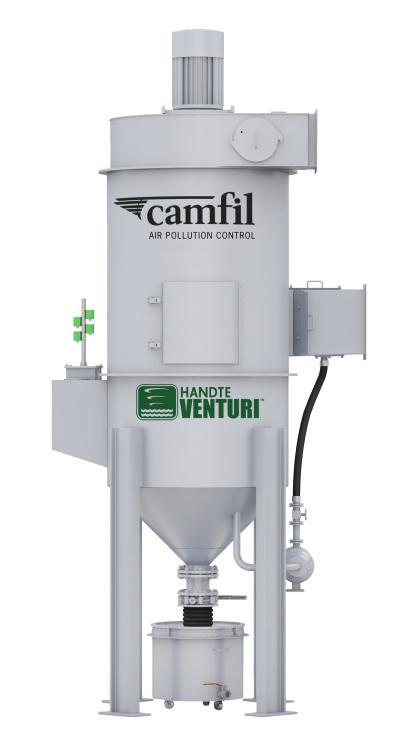
Metalworking processes like machining, sawing, grinding, buffing, polishing, fettling, brushing, drilling, cutting and abrasive blasting can create fine metal particles that become airborne and present an explosion hazard, if these metals are combustible. To help reduce this risk, Camfil APC offers Venturi and Vortex wet scrubbers. These high-performance, low-maintenance dust collectors provide a safe way to collect and remove combustible metal dust from the workplace. They are also suitable for metalworking processes that generate sparks.
The Venturi (pictured) is a high-performance wet scrubber for applications with high dust loading. The Venturi injects water via a pump into the inlet of the unit. Then extremely high velocities are generated to mix the scrubbing liquid and the contaminated air stream. The particle-laden droplets are then separated from the airstream by centrifugal force.
The Vortex is a compact and versatile wet scrubber that is ideal for processes that generate sticky or fibrous dusts. It brings the particle-laden air into contact with water, which creates turbulence and atomizes the liquid into fine droplets. These fine droplets are then separated from the airstream by centrifugal force.
Camfil Venturi and Vortex wet scrubbers are also for processes that emit a mixture of dust, gas, aerosols, vapors and fumes.
Contact Details
Related Glossary Terms
- abrasive
abrasive
Substance used for grinding, honing, lapping, superfinishing and polishing. Examples include garnet, emery, corundum, silicon carbide, cubic boron nitride and diamond in various grit sizes.
- brushing
brushing
Generic term for a curve whose shape is controlled by a combination of its control points and knots (parameter values). The placement of the control points is controlled by an application-specific combination of order, tangency constraints and curvature requirements. See NURBS, nonuniform rational B-splines.
- buffing
buffing
Use of rapidly spinning wires or fibers to effectively and economically remove burrs, scratches and similar mechanical imperfections from precision and highly stressed components. The greatest application is in the manufacture of gears and bearing races where the removal of sharp edges and stress risers by power methods has increased the speed of the operation.
- grinding
grinding
Machining operation in which material is removed from the workpiece by a powered abrasive wheel, stone, belt, paste, sheet, compound, slurry, etc. Takes various forms: surface grinding (creates flat and/or squared surfaces); cylindrical grinding (for external cylindrical and tapered shapes, fillets, undercuts, etc.); centerless grinding; chamfering; thread and form grinding; tool and cutter grinding; offhand grinding; lapping and polishing (grinding with extremely fine grits to create ultrasmooth surfaces); honing; and disc grinding.
- metalworking
metalworking
Any manufacturing process in which metal is processed or machined such that the workpiece is given a new shape. Broadly defined, the term includes processes such as design and layout, heat-treating, material handling and inspection.
- polishing
polishing
Abrasive process that improves surface finish and blends contours. Abrasive particles attached to a flexible backing abrade the workpiece.
- sawing
sawing
Machining operation in which a powered machine, usually equipped with a blade having milled or ground teeth, is used to part material (cutoff) or give it a new shape (contour bandsawing, band machining). Four basic types of sawing operations are: hacksawing (power or manual operation in which the blade moves back and forth through the work, cutting on one of the strokes); cold or circular sawing (a rotating, circular, toothed blade parts the material much as a workshop table saw or radial-arm saw cuts wood); bandsawing (a flexible, toothed blade rides on wheels under tension and is guided through the work); and abrasive sawing (abrasive points attached to a fiber or metal backing part stock, could be considered a grinding operation).
